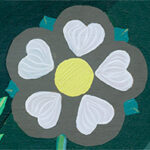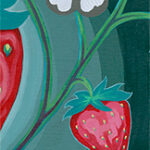Before using or adapting this methodology, please carefully read about the terms of use associated with its Creative Commons licensing and Traditional Knowledge Labels.
A PDF-version of the Gifts of the Heart Berry Info Poster is also available.
Components of Heart Berry Methodology
We can understand the heart berry plant as the collective community of Indigenous students with disability, allies, support and accessibility tools.
| Visual Representation | Heart Berry Meaning |
|---|---|
 The roots |
The roots reach deep into the land. They support and sustain the whole plant. Our roots connect us to our cultures. Accessibility that acknowledges and supports cultural identity and intersectionalities sustains and strengthens us. |
 The leaves |
The leaves transform the energy of sunlight into valuable nutrients. They are transformative locations that ensure the plant thrives. These transformative locations can look like collaborations, capacity building and reciprocal knowledge sharing. This fosters the creation of transformative spaces for disability and accessibility. |
 The flowers |
The flowers generate pollen. They are fertile grounds for generative idea creation regarding accessibility. This nurtures an understanding of disability through a social model and productive centers of accessibility. These flowers may be disability centers in academic institutions or accessibility tools. They are the basis for creativity, potentiality and abundance laying the foundation for the fruit to thrive. |
 The stems |
The stems are supportive structures. They support and provide a framework for the various intersections, or avenues of accessibility needs. They are also conduits connecting rooted cultural knowledge with accessibility tools, support centers and education paradigms. And they support the potentiality of fruit. |
 The berries |
The berries are the gift from the plants. They are the gifts that each Indigenous student with disability has to share. Each fruit is different in shape and texture. Each is unique and in differing stages of its own agentic expansion. Each fruit is filled with teachings, medicine, beauty, flavour, and nutrients. They are all nourishing and they all contain seeds. |
 The seeds |
The seeds are the unsprouted potentiality of the plant. They are the possibilities and potentialities generated by Indigenous students, academics, faculty and staff. When these seeds find nourishing soils, they become rooted and whole. This deepens our understanding of the actual accessibility needs of Indigenous students with disability and increases efficacy and capacity. |
 The shoots and runners |
The shoots and runners that move outward and sideways take root in various places to increase the capacity of the plant. These are the various ways in which knowledge is produced, shared and transformed. This might look like research, individuals, space creation, specific funding, facilitation and so very much more. The possibilities are endless. |
 The hands |
The hands are ancestors who have held us and brought us into being. The land and ecology are our ancestors and the concept of gifting is embedded within this ecology. The heart-berry plant is a gift from the Creator. |
 The arrows |
The arrows represent the four sacred corners that are central to many Indigenous cosmologies. They represent outward growth, courage and protection. |
| — |
The circles symbolize the cycles of seasons, time, and growth that are ever present in life. |
| N/A |
The cedar frame teaches us about collaboration, collectivity, our cultural roots, the Creator’s medicine, our ancestor’s wisdom and love, and the daily practice of ceremony. |
For Alisha’s background research, see this PDF file: Heart Berry Methodology Annotated Bibliography
